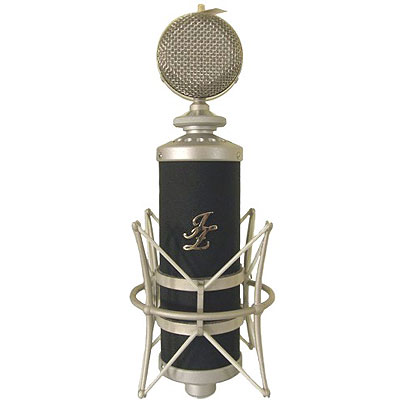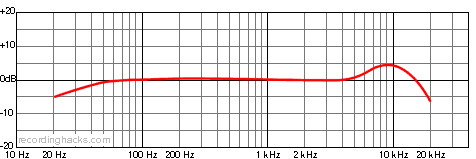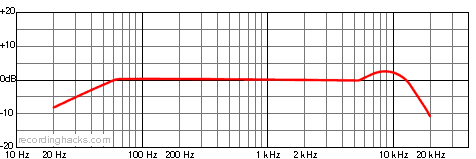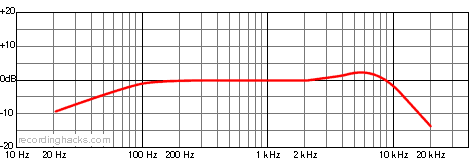 Blue Microphones Kiwi
Blue Microphones Kiwi
Multi-Pattern Condenser Microphone
The Kiwi is Blue’s top-of-the-line FET condenser microphone. Conceptually similar to the AKG C414, the Kiwi mates Blue’s dual-diaphragm B6 capsule, designed to evoke the sound of the CK12, to a solid-state amplifier circuit.
The B6 capsule is not intended to be a historically-accurate CK12 capsule; it is a 24mm (active diameter), center-terminated design with dual backplates. The capsule is shockmounted within the Kiwi’s headbasket.
A knurled, rotary switch on the back of the microphone body allows the mic’s directional pattern to be switched among 9 choices, from omni to cardioid to fig-8, with six intermediate positions (3 on each side of the center, cardioid setting).
The output circuit is a transformerless design with Class A electronics.
The Kiwi ships with an elastic shockmount, a metal-mesh pop filter called The Pop, and a cherry wood storage box.
 The Blue Kiwi, like several of Blue’s early products, was the subject of an intellectual property dispute in 2006, when the original manufacturer, SIA Scruples/Violet Design, attempted to register a lookalike microphone with the EU’s “Office for the Harmonization of the Internal Markets” — essentially the EU’s trademark office. The OHIM called Scruples’ registration invalid, awarding the IP rights to Martin Saulespurens of BLUE. For a time, this mic was known as the Violet JZ-3 or JZ3.
The Blue Kiwi, like several of Blue’s early products, was the subject of an intellectual property dispute in 2006, when the original manufacturer, SIA Scruples/Violet Design, attempted to register a lookalike microphone with the EU’s “Office for the Harmonization of the Internal Markets” — essentially the EU’s trademark office. The OHIM called Scruples’ registration invalid, awarding the IP rights to Martin Saulespurens of BLUE. For a time, this mic was known as the Violet JZ-3 or JZ3.
A significant difference between the JZ3 and Kiwi is that the JZ3 was a sort of Kiwi/bottle hybrid, in that the JZ3 accepted a full line of detachable capsules.
Electronic Musician, 2002
Skipper Wise, cofounder of Blue Microphones, describes the sound he was going for while developing the Kiwi capsule. His primary objective, he says, was a “continuousness” of sound or “absence of disjointedness” throughout the frequency response. “I don’t want to hear the top, mid, or bottom end being separate from the rest of the spectrum,” Wise says. “I have found, when this continuousness is achieved, that the whole sound appears to have depth.”
Wise evidently achieved his aims. The Kiwi is a wonderful-sounding mic that is natural and transparent overall, with a pleasingly musical balance of warm, solid lows; well-defined yet mellow mids; and a bright finish that brings subtle detail to the fore. The mic’s highs, though clearly bolstered, are smooth and well integrated and never sound brittle, harsh, or spitty. Furthermore, the images captured by the Kiwi have a hard-to-describe solidity and depth… by comparison, lesser mics can sound flat or one-dimensional.
The Blue Microphones Kiwi is also known as: JZ3, JZ-3.
The mic was released in 1999.
Specifications
| Frequency Response - OmnidirectionalClick Graph to Compare! |
|---|
 |
| Frequency Response - CardioidClick Graph to Compare! |
 |
| Frequency Response - BidirectionalClick Graph to Compare! |
 |
| Pickup Patterns | Pads & Filters |
|---|---|
|
Omnidirectional
(19 mV/Pa; 20 - 20,000 Hz) Cardioid (19 mV/Pa; 20 - 20,000 Hz) Bidirectional (19 mV/Pa; 20 - 20,000 Hz) |
|
| Capsule Dimensions | Impedance | SPL/Noise |
|---|---|---|
| Diaphragm diameter: 24mm Capsule diameter: 34mm Diaphragm gauge: 6 microns |
150 Ohms (Low) | Max SPL: 133 dB Self-noise: 8.5 dB(A) |
| Weight | Length | Max Diameter | Interface(s) |
|---|---|---|---|
| 880g (31.04oz) | 220mm (8.66'') | 60mm (2.36'') |
|
| Power Specifications |
|---|
|
Did we get anything wrong on this page? Please let us know!


